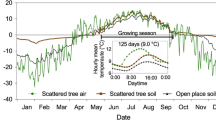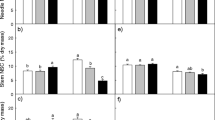Abstract
The carbon charging of pines across the treeline ecotone of three different climatic zones (Mexico 19°N Pinus hartwegii, Swiss Alps 46°N P. cembra and northern Sweden 68°N P. sylvestris) was analyzed, to test whether a low-temperature-driven carbon shortage can explain high-elevation tree limits, and whether the length of the growing season affects the trees' carbon balance. We quantified the concentrations of non-structural carbohydrates (NSC) and lipids (acylglycerols) in all tree organs at three dates during the growing seasons across elevational transects from the upper end of the closed, tall forest (timberline) to the uppermost location where groups of trees ≥3 m in height occur (treeline). Mean ground temperatures during the growing season at the treelines were similar (6.1±0.7°C) irrespective of latitude. Across the individual transects, the concentrations of NSC and lipids increased with elevation in all organs. By the end of the growing season, all three species had very similar total mobile carbon (TMC) concentrations at the treeline (ca. 6% TMC in the aboveground dry biomass), suggesting no influence of the length of the growing season on tree carbon charging. At a temperate lowland reference site P. sylvestris reached only ca. 4% TMC in the aboveground dry biomass, with the 2% difference largely explained by higher lipid concentrations of treeline pines. We conclude that carbon availability is unlikely to be the cause of the altitudinal tree limit. It seems rather that low temperatures directly affect sink activity at the treeline, with surplus carbon stored in osmotically inactive compounds.





Similar content being viewed by others
References
Bernoulli M, Körner C (1999) Dry matter allocation in treeline trees. Phyton 39:7–11
Cabrera HM (1996) Low temperature and altitudinal limits in plant ecosystems: Species responses to cold in tropical and subtropical mountains. Rev Chil Hist Nat 69:309–320
Cavieres LA, Rada F, Azocar A, Garcia-Nunez C, Cabrera HM (2000) Gas exchange and low temperature resistance in two tropical high mountain tree species from the Venezuelan Andes. Acta Oecol 21:203–211
Chapin FS, Shaver GR (1989) Lack of latitudinal variations in graminoid storage reserves. Ecology 70:269–272
Chapin FS, Schulze ED, Mooney HA (1990) The ecology and economics of storage in plants. Annu Rev Ecol Syst 21:423–447
Domisch T, Finer L, Lehto T (2001) Effects of soil temperature on biomass and carbohydrate allocation in Scots pine (Pinus sylvestris) seedlings at the beginning of the growing season. Tree Physiol 21:465–472
Egger B, Einig W, Schlereth A, Wallenda T, Magel E, Loewe A, Hampp R (1996) Carbohydrate metabolism in one- and two-year-old spruce needles, and stem carbohydrates from three months before until three months after bud break. Physiol Plant 96:91–100
Eggstein M, Kuhlmann E (1974) Triglyceride und Glycerin (alkalische Verseifung). In: Bergmeyer HU (ed) Methoden der enzymatischen Analyse, vol II. Verlag Chemie, Weinheim, pp 1871–1878
Fischer C, Höll W (1991) Food reserves of Scots pine (Pinus sylvestris L.) I. Seasonal changes in the carbohydrate and fat reserves of pine needles. Trees 5:187–195
Fischer C, Höll W (1992) Food reserves of Scots pine (Pinus sylvestris L.). II. Seasonal changes and radial distribution of carbohydrate and fat reserves in pine wood. Trees 6:147–155
Glerum C, Balatinezc JJ (1980) Formation and distribution of food reserves during autumn and their subsequent utilization in jack pine. Can J Bot 58:40–54
Goldstein G, Rada F, Canales MO, Zabala O (1989) Leaf gas-exchange of 2 giant caulescent rosette species. Acta Oecol 10:359–370
Gonzalez JA (1991) The annual TNC (total non-structural carbohydrates) cycles in two high mountain species: Woodsia montevidensis and Calandrinia acaulis. Bot Acta Cient Venez 42:276–280
Grace J, Norton DA (1990) Climate and growth of Pinus sylvestris at its upper altitudinal limit in Scotland—evidence from tree growth-rings. J Ecol 78:601–610
Grace J, Berninger F, Nagy L (2002) Impacts of climate change on the treeline. Ann Bot 90:537–544
Hoch G, Popp M, Körner C (2002) Altitudinal increase of mobile carbon pools in Pinus cembra suggest sink limitation of growth at the Swiss treeline. Oikos 98:361–374
Höll W (1985) Seasonal fluctuation of reserve material in the trunkwood of spruce [Picea abies (L.) Karst.]. J Plant Physiol 117:355–362
Holtmeier FK (2000) Die Höhengrenzen der Gebirgswälder, 1st edn. Natur and Wissenschaft, Münster
Jobbagy EG, Jackson RB (2000) Global controls of forest line elevation in the northern and southern hemispheres. Global Ecol Biogeogr 9:253–268
Khutornoi OV, Velisevich SN, Vorob'ev VN (2001) Ecological variation in the morphological structure of the crown in Siberian stone pine at the timberline. Russ J Ecol 32:393–399
Kontunen-Soppela S, Lankila J, Lahdesmaki P, Laine K (2002) Response of protein and carbohydrate metabolism of Scots pine seedlings to low temperature. J Plant Physiol 159:175–180
Körner C (1998) A re-assessment of high elevation treeline positions and their explanation. Oecologia 115:445–459
Körner C (1999) Alpine plant life: functional plant ecology of high mountain ecosystems. Springer, Berlin Heidelberg New York
Larcher W, Schmidt L, Tschager A (1973) Starke Fettspeicherung und hoher Kaloriengehalt bei Loiseleuria procumbens L. Desv. Oecol Plant 8:377–383
Lauer W (1986) Vegetational zonation of the Neotropis and its change since the Ice-Age. Ber Dtsch Bot Ges 99:211–235
Lauer W, Klaus D (1975) Geoecological investigations on the timberline of Pico de Oriza, Mexico. Arct Alp Res 7:315–330
Leuschner C (1996) Timberline and alpine vegetation on the tropical and warm- temperate oceanic islands of the world: elevation, structure and floristics. Vegetatio 123:193–206
Li MH, Hoch G, Körner C (2002) Source/sink removal affects mobile carbohydrates in Pinus cembra at the Swiss treeline. Trees 16:331–337
Miehe G, Miehe S (1994) Zur oberen Waldgrenze in tropischen Gebirgen. Phytocoenologia 24:53–110
Mooney HA, Billings WD (1965) Effects of altitude on carbohydrate content of mountain plants. Ecology 46:750–751
Ohsawa M (1990) An interpretation of latitudinal patterns of forest limits in south and east-Asian mountains. J Ecol 78:326–339
Oleksyn J, Modrzynski J, Tjoelker MG, Zytkowiak R, Reich PB, Karolewski P (1998) Growth and physiology of Picea abies populations from elevational transects: common garden evidence for altitudinal ecotypes and cold adaptation. Funct Ecol 12:573–590
Oleksyn J, Zytkowiak R, Karlolewski P, Reich PB, Tjoelker MG (2000) Genetic and environmental control of seasonal carbohydrate dynamics in trees of diverse Pinus sylvestris populations. Tree Physiol 20:837–847
Pantis JD, Diamantoglou S, Margaris NS (1987) Altitudinal variation in total lipid and soluble sugar content in herbaceous plants on Mount-Olympus (Greece). Vegetatio 72:21–25
Piispanen R, Saranpää P (2002) Neutral lipids and phospholipids in Scots pine (Pinus sylvestris) sapwood and heartwood. Tree Physiol 22:661–666
Pipp E, Larcher W (1987) Energiegehalte pflanzlicher Substanz: II. Ergebnisse der Datenverarbeitung. Sitzungsber Österr Akad Wiss Math Naturwiss Kl I:249–310
Popp M, Lied W, Meyer AJ, Richter A, Schiller P, Schwitte H (1996) Sample preservation for determination of organic compounds: microwave versus freeze-drying. J Exp Bot 47:1469–1473
Rada F, Goldstein G, Azocar A, Meinzer F (1985) Daily and seasonal osmotic changes in a tropical treeline species. J Exp Bot 36:989–1000
Rada F, Azocar A, Briceno B, Gonzalez J, Garcia NC (1996) Carbon and water balance in Polylepis sericea, a tropical treeline species. Trees 10:218–222
Saranpää P, Nyberg H (1987) Seasonal variation of neutral lipids in Pinus sylvestris L. sapwood and heartwood. Trees 1:139–144
Stevens GC, Fox JF (1991) The causes of treeline. Annu Rev Ecol Syst 22:177–191
Sveinbjörnsson B (2000) North American and European treelines: external forces and internal processes controlling position. Ambio 29:388–395
Tranquillini W (1959a) Die Stoffproduktion der Zirbe (Pinus cembra L.) an der Waldgrenze während eines Jahres. I. Standortklima und CO2-Assimilation. Planta 54:107–129
Tranquillini W (1959b) Die Stoffproduktion der Zirbe (Pinus cembra L.) an der Waldgrenze während eines Jahres. II. Zuwachs und CO2-Bilanz. Planta 54:130–151
Tranquillini W (1979) Physiological ecology of the alpine timberline. Tree existence at high altitudes with special references to the European Alps. Springer, Berlin Heidelberg New York
Troll C (1973) The upper timberlines in different climatic zones. Arct Alp Res 5:A3-A18
Tschager A, Hilscher H, Franz S, Kull U, Larcher W (1982) Jahreszeitliche Dynamik der Fettspeicherung von Loiseleura procumbens und anderen Ericaceen der alpinen Zwergstrauchheide. Acta Oecol 3:119–134
Vanninen P, Ylitalo H, Sievänen R, Mäkelä A (1996) Effects of age and site quality on the distribution of biomass in Scotts pine (Pinus sylvestris L.). Trees 10:231–238
Velazquez A, Cleef AM (1993) The plant communities of the volcanoes "Tlaloc" and "Pelado", Mexico. Phytocoenologia 22:145–191
Velez V, Cavelier J, Devia B (1998) Ecological traits of the tropical treeline species Polylepis quadrijuga (Rosaceae) in the Andes of Colombia. J Trop Ecol 14:771–787
Wardle P (1993) Causes of alpine timberline: a review of the hypotheses. In: Alden J (ed) Forest development in cold climates. Plenum, New York, pp 89–103
Wardle P (1998) Comparison of alpine timberlines in New Zealand and the Southern Andes. R Soc N Z Misc Publ 48:69–90
Webb WL, Kilpatrick KJ (1993) Starch content in douglas-fir—diurnal and seasonal dynamics. For Sci 39:359–367
Wong SC (1990) Elevated atmospheric partial-pressure of CO2 and plant-growth. 2. Nonstructural carbohydrate content in cotton plants and its effect on growth-parameters. Photosynth Res 23:171–180
Acknowledgements
This study was funded by the Swiss National Science Foundation, project no. 31–55173.98. We thank the following persons and institutions for their support during the field campaign: R. Dirzo, R.I. Martinez and H. Vibrans (Mexico), M.H. Li and J. Paulsen (Basel) and N.Å. Andersson and the Abisko Research Station of the Royal Swedish Academy of Science (Abisko). We are grateful to M. Popp and A. Richter (Vienna) for providing analytical advice and GC-access, O. Bignucolo for his help with part of the NSC-analyses, R. Bänninger, B. Bildstein, R. Riedl and G. Schaer for their assistance with the sample preparation and T. Fabro and T. Zumbrunn for retrieving our data loggers in Sweden.
Author information
Authors and Affiliations
Corresponding author
Rights and permissions
About this article
Cite this article
Hoch, G., Körner, C. The carbon charging of pines at the climatic treeline: a global comparison. Oecologia 135, 10–21 (2003). https://doi.org/10.1007/s00442-002-1154-7
Received:
Accepted:
Published:
Issue Date:
DOI: https://doi.org/10.1007/s00442-002-1154-7




